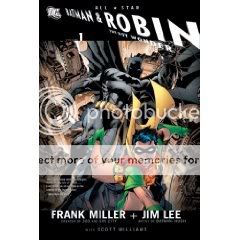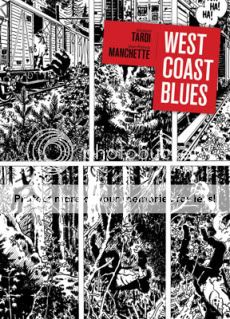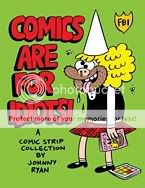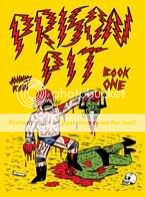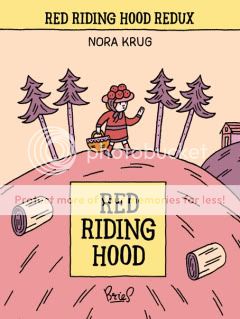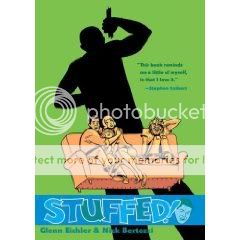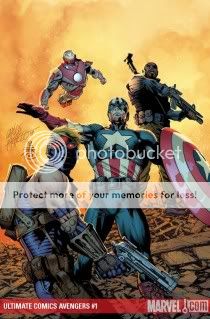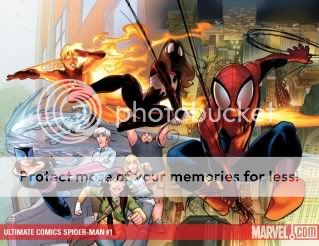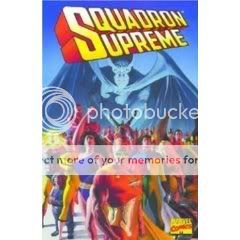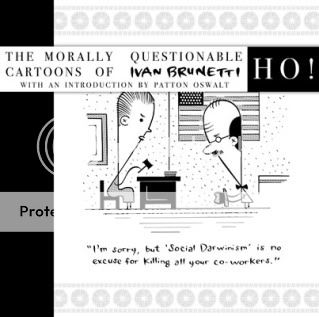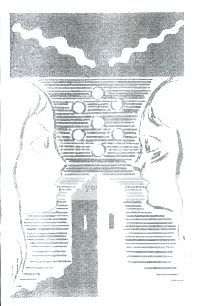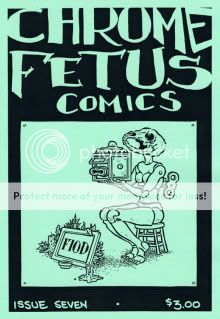Posts Tagged ‘Comics Time’
Comics Time: Agents of Atlas #10
September 7, 2009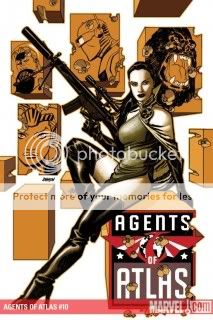
Agents of Atlas #10
Jeff Parker, writer
Gabriel Hardman, Paul Rivoche, artists
Marvel, September 2009
32 pages
$2.99
Credit for this excellent superhero comic must go first and foremost to colorist Elizabeth Dismang. Coloring this nuanced, engaging, and lovely in a superhero comic is a rare treat indeed, and from nighttime parking lots to forgotten mad-science labs to the red hair of the goddess Aphrodite to the sheen of a killer robot, Dismang imbues this issue of Jeff Parker’s strong off-model Marvel super-series with warm, sumptuous, tactile hues. Put it together with the just-so minimal-realism (is there such a thing) of Hardman and Rivoche and you have the best-looking variation on modern Marvel’s noir-naturalism house style since David Aja on The Immortal Iron Fist (or that Ann Nocenti Daredevil story everyone’s talking about). Right now I’m looking at a panel where Venus asks a wistful-looking Namora if she’s thinking about her old comrade and lover Hercules, and the team nails the emotion of it just as well as they handle the machine guns and robots of the action sequence that follows it. It’s really a joy to look at.
And that makes all the difference, doesn’t it? Books like Agents of Atlas, operating at the margins of the mainline superhero universe of which they are nominally a part, live and die on the strength and cleverness of their ideas, or specifically the variation they represent on the usual superhero ideas, if you follow me. But there are a lot of perfectly clever, perfectly nice minor superhero comics out there–you’ve probably read a lot of them–with art that never rises above the functional, and therefore who cares? But you care about the Agents of Atlas after reading a gorgeous-looking, well-constructed issue like this. Parker packs its pages with idea after idea–you get more exposition on this whole “warring Dragon Clans” idea that makes for a nice fit with the kinds of things Iron Fist fans would appreciate; you get a crazy Weapon Plus-style look at the decades-old killer-robot production program Atlas has instituted; you get a big giant battle with souped-up automatons. But more importantly, you also get that great calm-before-the-storm feeling you’ll remember from your favorite action movies, with the characters collecting their thoughts, bonding a bit, but also making damn sure they’re ready for whatever’s about to come through that door. I know that sounds like such a cliche, but here it feels fresh, rooted to this specific motley crew of characters drawn from the various corners of the Marvel Universe and thrown together by the accident of when they were first published. You’ll believe a top-notch, visually and emotionally engaging comic can be made out of an Atlantean queen, a siren, a talking gorilla, a mute robot, a Uranian-Earthling hybrid guy, a dragon, a bunch of knowing yellow-peril/dragon-lady pastiches, a thawed-out secret agent from the ’50s, an Art Bell knockoff, and some warp zones. Like Mike Mignola, John Arcudi, and Guy Davis’s B.P.R.D., it’s an ensemble action book with brains, looks, and heart. Well done all around.
Comics Time: Inkweed
September 4, 2009
Inkweed
Chris Wright, writer/artist
Sparkplug, 2008
152 pages
$16
I didn’t want to like this comic. I didn’t even want to read it. There’s something…off-putting about that cover, a weird combination of Klasky-Csupo/Gary Baseman character design I never found that appealing and just a lot of brown, empty space. The interiors similarly failed to pull me in–lots of crosshatched backgrounds and clothing placed behind and draped around a cast of sub-Muppets. In order to keep myself sane, my usual criteria for whether I’d even read a comic at all is that I at least have to enjoy flipping through it, so I was sorely tempted to leave this on the shelf and would have done so but for the good things I half-remember hearing about it. Plus, it seemed like it’d be a quick read.
What I didn’t count on is the writing. Good Lord. I’m still not 100% sold on his art, but the Chris Wright stories collected here are sharp as a knife, just as incisive, just as likely to leave a wound. Most concern older people coming to terms, or failing to, with their failures: a painter who seems to have traded acclaim for ability, an astronomer who falls in unrequited love with his assistant, a witch who cultivates fine blends of pipe tobacco for an unappreciative Satan, a famous author whose equally gifted but resentful son comes between him and his young wife, another painter whose drinking gives him an outlet for his extravagant self-loathing and a cover for his fear of failure. I suppose these are all fairly well-trodden paths–you don’t have to have read Asterios Polyp recently to feel like you’ve gotten your fair share of stealth-autobio art about the struggles of artists. But Wright is distinguished by the swift and brutal way he deals with the themes. The ends of his stories tend to leave the characters staring down the abyss in matter-of-fact fashion–literally, in the case of the astronomer, who can only gaze once again into his telescope, and in the case of the famous painter, who must trade his blank canvases for the blankest canvas of all. Other stories end with no-nonsense cris de coeur: “What’s wrong with me?” asks the alcoholic painter; “FUCK!” yells a man whose confrontation with God over the heartache he feels has been abruptly cut short mid-sentence when God vanishes with a Nightcrawler-style BAMF. The lead-ups to these grand finales are unsparing as well, particularly the story about the father and son authors and the father’s wife–that one takes a swing-for-the-fences turn for the disturbing that still manages to preserve the humanity and agency of all the characters involved rather than reducing any of them to something for someone else to react to. Wright accomplishes that in part by pushing the most extreme reactions off-panel, just one of any number of extremely shrewd storytelling choices he makes in here.
And you know, the art does have stuff to recommend it after all. Populating his stories with dollar-store Fraggles may be off-putting at first glance, but it can keep the stories from getting too maudlin or too on-the-nose. It also strangely enhances the period feel of the material–watching these creatures roam around in 19th-century garb reminds me of half-remembered cartoons in which anthropomorphized animals acted out human conflicts in old-timey settings. But his strongest visual flourish is the way he can slowly zoom in and out of abstraction in the middle of his stories, focusing only on the patterns created panel to panel by hands, eyes, stars, candles, enabling our minds to make sense of the images as the characters similarly grapple with their thoughts and emotions. Wright eventually lets this get away from him a bit toward the back of the book in a series of abstracted one-page strips and illustrations–the strongest of these, a short and bitter near-poem about alcoholism, is also the most straightforward. But the way he works such sequences into his traditional short stories bespeaks confidence and skill. This is already one of the best-written comics I’ve read in quite some time–goodness knows where a few more years at the drawing table will take him.
Comics Time: Soldier X #1-8
September 2, 2009
Soldier X #1-8
Darko Macan, writer
Igor Kordey, artist
Marvel, 2002-2003
32 pages each
$2.99 each
Comics Time: Flash: Rebirth #4
August 31, 2009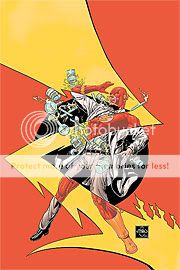
Flash: Rebirth #4
Geoff Johns, writer
Ethan Van Sciver, artist
DC Comics, August 2009
32 pages
$3.99
If you know Geoff Johns, and particularly if you know his work on this project’s thematic predecessor, Green Lantern: Rebirth, you knew this was coming. This is the issue where Johns redefines, organizes, and expands the Flash mythos, tying together various elements and explaining how revived hero Barry Allen is an indispensable part of them all. The following thoughts about this aren’t quite Flash Facts–maybe they’re Allen Opinions?
This was nowhere near as elegantly done as the reveal of the “emotional spectrum” concept in Green Lantern, or even the “Parallax was a separate entity” reveal from GL: Rebirth. I think that’s because the core concepts being utilized here aren’t as easy to instantly grasp. With Green Lantern, if you were gonna bring back mass murderer Hal Jordan you had to come up with a reason why it’s okay for us to like him again, and “he was possessed by a demonic yellow fear elemental at the time he killed all those people” is a pretty easy one to get behind. And once you’ve established that arch-enemy Sinestro’s power ring is fueled by fear in much the same way that GL’s ring is fueled by willpower, it’s a logical leap to other colored rings being fueled by other states of mind.
By contrast, the big revelations here…well, I’ve never quite understood what the heck the Speed Force is supposed to be anyway. For years I labored under the misapprehension that it was some pseudomystical thing, like what J. Michael Straczynski did with that horrible “Spider-Totem” idea in Amazing Spider-Man–so that instead of that accident with the lightning striking Barry Allen while he was holding some chemicals giving him his powers, that just opened up some portal to the Speed Force or something, just like how in JMS’s justly ignored origin revamp the spider was magical and the radioactivity was just a coinicence. I’ve since learned that I was wrong and the Speed Force was just something out there that people who got super-speed through whatever means became able to commune with or tap into or whatever the proper term might be. Either way, this is a much wonkier concept than “rainbow of space armies,” and so rejiggering things so that now Barry Allen’s accident created the Speed Force doesn’t have the same oomph as “the reason Green Lanterns were vulnerable to yellow is because of the giant yellow Fear Monster inside the Power Battery.”
Same with the revelation that there’s a Negative Speed Force embodied or utilized or whatever by Professor Zoom, the Reverse Flash. To convey this idea, Johns and Van Sciver tie it to the fact that the Flash’s speed lightning is yellow while Zoom’s is red. Frankly, I’d never noticed this before–it’s certainly not a famous concept like Green Lantern’s green ring vs. Sinestro’s yellow one, or even just “the Flash wears red while the Reverse Flash wears yellow.” Without that easy-to-envision visual hook, it’s a much tougher sell; all Van Sciver’s little design flourishes and neato ways of showing superspeed Van Sciver can’t quite make up for it.
However, there were quite a few things I liked in this issue. For starters, I appreciate the way Johns has shifted the generative spark for the Flash’s powers back to that lightning/chemicals accident instead of positing some preexisting speedster ether floating around out there. Now it’s all a result of Barry’s accident, ripples from which apparently spread throughout all of time and space–which moreover is as good an answer as any to the question “Why is this Flash different from all other Flashes?” Plus, I feel like we’re closer than ever to a speedster team book called Speed Force, which is far past due, and since I don’t have a dog in the Jay vs. Barry vs. Wally vs. Bart vs. Max Mercury vs. whoever the hell else race (no pun intended), it could star any of these guys and I’d be fine with it. The prospect of the Flash Family being its own little squad centered on one of DC’s coolest superhero concepts, like the Green Lantern Corps or Batman and his Robins or the Super-people, is pretty appealing.
But I suppose the main reason I’m not letting my problems with Johns’s solution to the Flash equation is that I’m not convinced we’ve seen the end of it. For example, I have to assume an explanation is in the offing that ties the new, time-jumping Zoom in with Professor Zoom’s negative Speed Force. Maybe Johns will explain (by which I mean invent, of course) why non-Speed-Force-using Superman is able to keep pace with the Flashes. Maybe that turtle villain who slows things down will be revealed as some sort of Slow Force avatar. Maybe there’s some sort of Superhero String Theory in the offing that connects the Speed Forces to the Emotional Spectrum to Anti-Life to the Purple Healing Ray to New Order’s “Blue Monday,” I dunno. I appreciate the effort of imagination needed to put it all together and await its continued rollout.
Comics Time: Big Questions #12: A Young Crow’s Guide to Hunting
August 28, 2009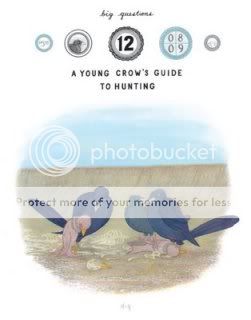
Big Questions #12: A Young Crow’s Guide to Hunting
Anders Nilsen, writer/artist
Drawn & Quarterly, 2009
24 pages
I don’t remember what I paid for it–$6.95, maybe?
I’m sure you’ll be able to buy it from Drawn & Quarterly eventually
Of the three action comics I reviewed this week, the most thrilling, best choreographed, most suspenseful, most pulse-pounding was not the Frank Miller/Jim Lee team-up or the Geoff Johns event comic but a little black and white story about birds. In this antepenultimate installment of Anders Nilsen’s long-running magnum opus, things come to a head between our “hero” birds and the big black crows who’ve been harassing them throughout this bleak story about how difficult it is to process tragedy. Because it has been so bleak, the tension here is almost unbearable. As the crows make a mockery of the birds’ noble but feeble attempts to defend themselves, just one big question filled my brain: Just how far will Nilsen take this?
As the action picks up the panel borders disappear, leaving Nilsen’s already feather-delicate images feeling more vulnerable and exposed than ever. Each image is a marvel of composition and clarity as the black and white birds clash, calling to mind everything from yin and yang to that incongruous cover image on the original hardcover versions of Stephen King’s The Stand. Each visual beat is so strong, and complemented so chillingly with the crows’ callous dialogue, that even as I raced to find out what happens, I couldn’t help but linger on every panel, trying to squeeze out every last bit of detail. I refuse to spoil the ending, whether devastating or joyous–frankly, everyone should experience it for themselves–but I will say that it made me more confident than ever that Big Questions is a masterpiece in the making.
Comics Time: All Star Batman & Robin, the Boy Wonder
August 26, 2009All Star Batman & Robin, the Boy Wonder Vol. 1
Frank Miller, writer
Jim Lee, artist
DC, 2009
240 pages
$19.99
Now that this first volume of Frank Miller and Jim Lee’s, uh, controversial Bat-book is out in a nice fat trade paperback, I finally sat and read its nine issues’ worth of comics from start to finish for the first time. Then I sat around and tried to figure out what to say about it. One phrase kept leaping to mind no matter how much I tried to come up with an alternate approach, so fuck it: That phrase is “mentally ill.”
But I mean it in the best way!
I understand that Miller’s staccato and repetitive dialogue and narration is enough to give some people aneurysms. Ditto, and more so depending on whether you’re talking about some of my former coworkers at Wizard, his new take on Batman as a cackling, grinning, foul-mouthed, stubble-sporting, child-abusing psychopath. For pete’s sake, former editor Bob Schreck’s introduction to the volume is nothing more or less than an apologetic for what follows. But I know self-parody when I see it–and honestly, even if Miller really isn’t capable of writing in any other way anymore, that doesn’t make it any less of a self-parody–and I have no attachment to some platonic ideal of Batman. In point of fact I actually have long felt Batman would have more fun pounding the bloody bejesus out of criminals than we’ve been led to believe. In the immortal words of J.R. “Bob” Dobbs, fuck ’em if they can’t take a joke.
And you know, the thing really is (to quote Grant Morrison’s Mad Hatter) very much cleverer than its rep as a goddamn-Batman meme generator would indicate. Miller is constantly getting Lee to play around with panel layouts in memorable fashion, from the Bendis-like talking-head array during Batman and Dick Grayson’s conversation in the Batmobile to the gigantic splash-page extreme-closeups of the Robin and Superman logos (the impact of which is muted somewhat by similar treatment of other images to fill up space in the collection, but still) to the outrageously over-the-top barroom banter juxtaposed with an image of a burning fuse during the Black Canary’s introduction. There are even a couple moments that recalled the genuine madcap wit of mid-period Miller (roughly from The Dark Knight Returns through Hard Boiled)–a great jumpcut reveal of Dick’s kidnapping ruse during the Dynamic Duo’s confrontation with poor befuddled Green Lantern, and that massive multi-page fold-out of the Batcave that just keeps unfolding. By the time I got to the fourth fold, I was laughing out loud. Though Jim Lee has aged into his “nicest guy and biggest artist in comics” role very gracefully, he’ll never be the formal innovator (or popularizer of others’ innovations) that Miller has been, but even still, all these moments shine quite aside from his primary selling point of drawing DC’s characters as heroic and awesome and eye-poppingly big-big–BIG as possible. Put it all together and it’s a pleasure to flip through this book.
That’s not to say that the “this goes to 11” tone works all the time. There’s just no way to carry off any kind of emotional nuance if everyone sounds like a manic cross between Raymond Chandler and Matthew Perry’s Chandler. At one point, you’re supposed to infer from Vicki Vale’s speech pattern that she’s in shock, but she just sounds like everyone else (I imagine that was intentional, but it’s still a bit flummoxing). Meanwhile, the selling point of Miller’s Joker, back since DKR, is that he’s unsmiling and quiet, but his internal monologue is as chatty as all the other characters’. It doesn’t help that the Joker has always been one of Lee’s weakest interpretations of DC’s characters, the nose too pointy, the face too demonic. And honestly, Lee’s polished work is the reason that this book, at its best, will always just be really entertaining, whereas I truly think that the raw power Miller’s own The Dark Knight Strikes Again (or his crazy gorgeous alternate covers for ASB&R, reprinted here) is like a message from an alternate future for superhero comics.
But having the first nine issues of the book collected in one place does a lot to clarify what’s going on. For example, no longer does the Batmobile ride seem to go on for weeks (though Miller inserted a joke about that)–it just seems like one more feverish element in a story paced like a series of exclamation points. And tackling those initial, hostile conversations between Batman and Robin just a few minutes before you come to this arc’s comparatively quiet graveside denouement helps you realize that hey, this book just might be about Robin’s buoyant presence dragging Batman back from the brink of lunacy as we were promised after all! It certainly makes a convincing case that running around dressed as a bat and hospitalizing people all night for a year or so would drive you, well, batshit. Maybe that’s the quality, the tone, that Miller’s trying to capture more than anything else. I mean, there’s an issue where Batman and Robin lure Green Lantern into a room painted from floor to ceiling in bright yellow–so are they, though unfortunately we don’t see how that came to be–and Robin steals his power ring and crushes his windpipe so they have to perform an emergency tracheotomy on him. Mentally ill, meant as a compliment.
Comics Time: Blackest Night #0-2
August 24, 2009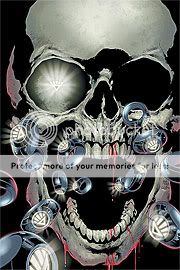
Blackest Night #0-2
Geoff Johns, writer
Ivan Reis, artist
32 pages each
#0: Free
#1-2: #3.99 each
Despite months of “Prelude” issues (whole story arcs, actually), a zero issue, and a “Prologue,” in Green Lantern #43, it’s the official first issue of Geoff Johns’s years-in-the-planning event comic Blackest Night that counts. And to be honest, my first read-through left me cold, largely by way of contrast.
That first Sinestro Corps Special a few years back was a first-round knockout–nutso heavy-metal character designs and all-out ring-on-ring action by Ethan Van Sciver, a Humpty Dumpty Green Lantern getting shot in the head, and a final “holy crap, this is going to blow you away if you’re a giant fucking nerd” secret bad-guy reveal splash page that, since I am a giant fucking nerd, blew me away. By comparison, BN #1 doesn’t have a whole lot going on. The “hey wouldn’t it be neat if…” idea of different-colored Lantern Corps isn’t new anymore. Both the comic’s general premise of dead heroes being brought back to life as killer zombies and the identities of many of the specific heroes to be revived were already common knowledge for most semi-savvy superhero fans. Van Sciver’s career-best art, and Doug Mahnke’s star turn on the tie-in issues of the main Green Lantern title–both of them weirder and harder-edged than mainstream comics need to be, with Mahnke in particular edging upward toward the top mainstream tier of Quitely, Romita Jr., Cassaday, and Frank–are replaced by the stalwart but pretty traditionally superheroey art of Ivan Reis, looking like Jim Lee scaled back toward Neal Adams a bit but somehow muddier and murkier than he’s been on GL in the past. There’s no last-page reveal at all. And the violence is extreme even by dismemberment enthusiast Johns’s standards.
But I think that this was ultimately a case of me expecting something different than what Johns was attempting to deliver. He doesn’t need to launch several years’ worth of future stories here–instead, he needs to tie several years’ worth of past stories by writers across the DC line together. He doesn’t need to kick off a thrilling saga of space-faring combat–he needs to start telling a horror story about dead superheroes coming back to life and murdering their friends. He doesn’t need to redefine and reinvigorate a character and his mythos–he needs to serve up a series of snapshots of multiple characters and the mythos of the entire DC Universe.
So rather than writing a review of BN #1 the second I bought it, I sat on it, keeping it in my backpack and pulling it out every now and then for another flip-through, another read. Now that I knew what to expect, I started to enjoy it, and the following issue, a lot more. I could admire how Reis made the Black Lantern versions of kindly old superheroes like Martian Manhunter and Aquaman into hulking, uruk-hai-style physical and existential menaces. I could get a kick out of his little flourishes, like the impressive Green Lantern hologram display of all the DCU’s dead heroes, or his riff on Rags Morales’s hyperthyroidal Hawkman (now the standard portrayal of the character, much to my amusement and delight). I could chuckle at the “jump scare” of turning a page on a quite rooftop conversation between Commissioner Gordon and his daughter Barbara to suddenly find Hal Jordan’s plummeting body smashing the Batsignal into pieces.
For as long as I’ve been reading it, Johns’s superhero writing has consisted almost solely of finding ways to express through action and dialogue exactly what each of DC’s superheroes means. As they fight, heroes will explain what it is that makes them tick and what iconic qualities they represent in DC’s pantheon, while villains will berate them for failing to live up to those demands. If this sounds boring or precious, most of the time it’s neither, because Johns just happens to be really good at identifying those core components of each character and basing fun action adventures around them. With the exception of the Justice Society of America–there’s just no way to remove the smell of mothballs and Ben-Gay from a team full of septuagenarians, guys in gimp masks, and (oddly) perky teens–his major recent works, lengthy runs on Action Comics and Green Lantern, have been like a carefully curated retrospective of Superman and Green Lantern’s careers, enemies, and milieux. At this point, if my comics-curious best friend from high school asked me to loan him comics that would inform him as to why Supes or GL are awesome, they’re what I’d hand him.
I guess that the idea behind Blackest Night is for Johns to take aim not so much at any particular character or even set of characters but at a basic fact of life for the DC Universe itself, the simultaneous omnipresence and impermanence of death. Everyone’s always getting killed (editorially speaking, Dan DiDio’s tenure at the top has been like a Robespierrian reign of terror for the men and women in tights) yet everyone’s always getting brought back to life (at the same time he’s been reviving more dead people that Jesus and George A. Romero combined). The power of the Black Lanterns reanimates dead heroes as extremely violent and extremely douchey killing machines, who taunt and mock the heroes they target for death, who are then brought back to life in the same fashion to continue the cycle. Depending on how much credit you’re willing to extend Johns, you could argue that this concept makes literal the way the constant death/rebirth cycle makes a metaphorical mockery of whatever import these characters’ adventures are supposed to have with us. If it’s all a wash eventually, what the heck difference does all the blood sweat and tears, all the rage and avarice and fear and will and hope and compassion and love that drive the multicolored Lanterns, even make?
Chances are a lot of you are simply saying “Jimmy crack corn and I don’t care.” Unless you have some basic investment in the idea that these characters can still be used to tell involving stories, this probably won’t mean much to you. Moreover, unlike Grant Morrison, Johns’s evangelical belief in the power of superheroes isn’t accompanied by the experimentalist brio that’ll hook the hipsters. He’s simply trying to make a really good superhero comic book. But here’s the thing: A little faith is all you need. As other people have gone into in great detail, Johns strove to make this thing as new-reader friendly as a comic that culminates in the Elongated Man and his rape-murdered wife rising from the dead and slaughtering the umpteenth incarnation of Hawkman and Hawkgirl can be. Obviously I like superhero comics and have read quite a few, but without having read them as a child, I lack the masters degree in minutiae that many fans, particularly self-identifying DC fans, seem to view as a necessity. Therefore, while I think I’d heard the names of, say, Aquaman’s little posse of Garth and Mera and Tula and Dolphin before, I had no idea who the hell they were when they all showed up to fight over Aquaman’s grave. But because Johns’s writing is always primarily concerned with explaining and exploring each character’s role in the pantheon, I didn’t need to know who they were–it was explained to me between, and during, punches. So then it becomes a scene not about trivia questions, but about characters’ past mistakes and biggest failures literally coming back to destroy them. It’s quite effectively done. It’s not knocking me on my ass the way Final Crisis did, but who says it needs to? It’s a fun, violent superhero comic that has a sense of weight, a sense that within its confines, what’s happening to the characters, despite all the dying and rebirthing, matters to them. Clearly it matters to Johns, and I think his ability to translate that into writing that’s creative and entertaining rather than insular and pathetic is his personal power ring.
Comics Time: West Coast Blues
August 21, 2009West Coast Blues
Jacques Tardi, writer/artist
adapted from the novel by Jean-Patrick Manchette
Fantagraphics, 2009
pages, hardcover
$18.99
In a book like this, where a cartoonist is adapting a novel you haven’t read, it’s difficult to say who deserves credit for what. All I know is, someone deserves a lot of credit. As slim, smooth, and hard as its attractive, Adam Grano-designed album-style hardcover format, West Coast Blues is as strong a crime comic as you’re likely to see this year (or until whenever the next Gipi Wish You Were Here Ignatz book comes out). So maybe it’s weird for me to start by talking about the problems I had with it, but let’s get them out of the way: Certain basic character components are things you’ve seen many times before. There are hitmen who banter innocuously between dispassionate murder attempts, a torturer who loves his dog, and a protagonist who doesn’t seem attached to anyone but his own hide. Which is weird, since the protagonist, George, is just an average joe. Maybe there are people out there who, when suddenly targeted by murderers, would be able to ditch their families and entire lives without feeling much of anything about it, but I don’t think I know any, and I’m certainly not one of them. All I do is feel. Sometimes I think crime fiction would be a lot more effective if, as is often the case in real life, the crime really visibly fucked the victims up. (Though to be fair, there are other characters we come across for whom it’s done exactly that.)
What the book does right makes for a much longer list than what it does wrong. For starters, there’s Tardi’s art, a master class in spotted blacks and lines like garrote wire. Tardi juxtaposes cartoony figures against frequently photorealistic backgrounds and objects like a manga-ka, but his characters of a rubbery Rick Geary look that’s at once lighthearted and ugly. This makes them perfect vessels for the story’s sudden bursts of apocalyptic violence, which appear out of nowhere, rain mayhem all over a couple of pages, and then vanish like a summer storm, returning us to our taciturn hero and his quotidian environments. I think everyone will talk about the beach attack, for instance–how well Tardi conveys a Jaws-like seashore scene so sunny and crowded with swimmers that a man could be assaulted and drowned without even those closest to him realizing that anything was going on but horseplay. It was a stroke of genius for this to be the first big setpiece, sending the message that bad shit could go down anytime, anyplace. Just as impressive, and just as well-choreographed from an action perspective, is the book’s central one-two-three punch: a chaotic shootout, an assault by a ghoulish hobo, and the tumble from a train through a seemingly Mirkwood-like forest that’s seen on the book’s cover. After a prolonged period of Godot-like waiting for something to happen, it all seems to happen at once, leaving both George and the viewer dazed and confused amid Tardi’s riot of a woods. George emerges from the other side of this sequence as another person, in a literal sense, and it’s such bravura storytelling we can innately understand why.
The end of the book (and the beginning) seem to want to raise bigger questions than the basic plot–essentially, “no good deed goes unpunished”–would appear to offer. I suppose it’s to Tardi and Manchette’s credit that they try to address my complaint about George’s weird stoicism more or less head on, though I’m not sure I buy their explanation. But it left me thinking, I’ll give them that, and a book that can leave me thinking after keeping me turning the pages as fast as I can is a book that got it done if you ask me. I even liked how people’s howls of pain were simply portrayed as giant letter A’s. This sucker’s good.
Comics Time: Comics Are for Idiots!: Blecky Yuckerella Vol. 3 and Prison Pit Vol. 1
August 19, 2009Comics Are for Idiots!: Blecky Yuckerella Vol. 3
Johnny Ryan, writer/artist
Fantagraphics, 2008
104 pages
$11.99
Prison Pit Vol. 1
Johnny Ryan, writer/artist
120 pages
$12.99
One of these comics features a giant monster made of semen, a guy who shoots acidic puss out of his body acne, and a slug who sucks cock. The other is a Johnny Ryan gag-strip collection.
Yes, both of these books are like kryptonite to good taste. But there are a couple of big differences between what Johnny Ryan is doing in Comics Are for Idiots!, his latest Blecky Yuckerella strip collection, and what he’s doing in Prison Pit, his ultraviolent action-comic debut. The most obvious is he switched from brush in the former to pen in the latter, stripping himself of his secret weapon: one of the lushest lines in comics. Turns out it was a smart move. With Blecky, the buoyancy of his slick black swooshes and swoops is reflected in his figurework: everyone’s googly-eyed, grinning and chortling like, well, idiots, and if they’re not doing that then they’re gasping or being knocked out of the panel, feet flying in the air, their shock or disgust just as joyous as their glee. That’s how gags about curing brain tumors by exposing them to dogshit or throwing babies in the trash (and to be fair, this is nowhere near as bad as things have been getting in Angry Youth Comix lately) still manage to get you to laugh along with them–they’re just so exuberant! Prison Pit, on the other hand, is all business. Yes, tongue’s in cheek to a certain extent–in addition to the gross-out bits I mentioned above, all the characters look like rejected He-Man concepts, there’s gratuitous swearing and swastikas, the portentous opening chapter heading reads “FUCKED” while the second chapter is called “MEGA-FUCKED,” and Ryan has said he’s swiping liberally from ridonkulous action manga like Berserk. And yet the tone feels as serious as a heart attack, thanks in no small part to a line that’s gone wiry and vicious, able to evoke the doom-laden skies of Gilbert Hernandez’s Chance in Hell, the nightmarish stone wastelands of Mat Brinkman’s Teratoid Heights, the seedy body-horror of Josh Simmons, the painstaking monumentalism of Tom Gauld. At times when the visuals are at their most abstract, you’d be hard pressed to recognize Ryan in them at all.
The second big difference is one of pacing. The four-panel Blecky strips often feel like a breakneck race to the punchline through some kind of bizarre obstacle course requiring the basic premise of the gag to get more ridiculous with each panel. It’s not enough for Blecky to get a pair of x-ray spex–she has to use them to spy on Wedgie’s kidney, and the kidney has to be anthropomorphized, and it has to be going through the personals column, and it has to be circling ads for both men and women, so that the ultimate joke is that Wedgie has a bicurious vital organ. Maybe the best distillation of this kind of set-up features Blecky’s Aunt Jiggles getting her ass caught in a jelly jar, her boobs caught in a coffin lid, and her head caught in a bird’s vagina one panel at a time, for a payoff panel of Blecky saying “You’re the coolest person I’ve ever met.” Rapid-fire ridiculousness is the height of virtue here. Compare that to Prison Pit, which opens with an abstracted, dialogue-free spaceship landing that lasts for four pages. Similar space is given to the protagonist getting wrapped up in someone’s prehensile intestines, or cutting someone’s head off, or falling through the sky, or tumbling down a mountain, or simply losing consciousness. This meticulous rolling-out of physical business is occasionally contrasted with dramatic splash pages–from an x-ray view of the hero’s circulatory system to a disembodied portrait of his penis–but for the most part, this giant fight scene feels disconcertingly quiet, lonely, and loveless, right down to its skin-crawling coda. Ryan’s rep as altcomix’s premier overgrown juvenile delinquent is well deserved–and don’t get me wrong, you can absolutely enjoy Prison Pit on that level–but the poetic savagery he depicts here is the work of a grown-ass man.
Comics Time: Red Riding Hood Redux
August 17, 2009Red Riding Hood Redux (Red Riding Hood, The Wolf, The Grandmother, The Mother, and The Hunter)
Nora Krug, writer/artist
Bries, 2009
80 pages per volume
$5 individually, $20 for the set, if I recall correctly
I’m going to make Nora Krug’s multifaceted, wordless retelling of the Little Red Riding Hood story sound dreary and depressing if I say that it’s about the ugly business of adult life: Grief, greed, alcoholism, joyless sex, irrevocable mistakes, brutal dominion over animals. The thing is, it’s not not about those things–they’re present in the five interlocking little volumes, each presenting not just the point of view but the literal eye-view (and sometimes mind’s-eye-view) of a different character in the story, that are bundled together with a rubber band to form the overall package. But Red Riding Hood Redux is also about vivid and skillful use of color, clever formal play, astute visual shorthand, baroque and virtuoso storytelling, funny comic business, and the sheer pleasure of telling a shaggy dog tale. Krug deftly reintroduces us to the specifics of the Red Riding Hood story, from the stuff we all remember (“What big ears you have!”) to the stuff we thought we’d forgotten (Grandma and Red filling the sleeping wolf’s belly up with rocks in order to dupe him into still feeling full after the hunter frees them). Oftentimes she presents us with only the half of key sequences and conversations that our current POV character can see, leaving us to fill in the blanks first mentally and then, with great pleasure, through the other side of the story when we get to the other characters’ versions. But just as much fun, if not more, are the aspects of the tale Krug concocts on her own. Maybe there really was a love triangle between Red’s mom, the hunter, and Red’s dad, who by the way was imprisoned for the accidental killing of Grandpa, but I sure never heard it in the versions of the story I was told; Krug imbues this whole bedroom drama with heart, laughs, and real regret. At other times she gets fanciful, creating a bizarre Journey to the Center of the Earth-style world-within-world inside the Wolf’s belly, and continuing the Wolf’s story post-mortem in a fashion that delighted this animal lover to no end. Krug’s simple line and deft coloring are both perfect fits for the project, keeping things childlike while still able to convey all kinds of information and emotional content within the sparse one-frame-per-page set-up she’s using. Heck, just the way she drew Grandma and Red’s views when they get drunk was worth the price of admission. If you can snag this, by all means do so.
Comics Time: Stuffed!
August 14, 2009Stuffed!
Glenn Eichler, writer
Nick Bertozzi, artist
First Second, 2009
128 pages
$17.99
While I can’t say I recommend this book without reservations, I also can’t say I’ve ready very many comics about the moral and ethical issues surrounding the depatriated, taxidermied body of an African. Along with Nick Bertozzi’s always elegant, full-of-life cartooning, it’s that subject matter that will get Stuffed! over with those for whom it’ll get over. In Colbert Report writer/Daria helmer Glenn Eichler’s story, two estranged brothers–happy, if harried, suburbanite Tim and acid casualty Free–come into the possession of the stuffed human remains of a man from Africa, who’d been displayed as a curio in their surly late father’s rinky-dink museum of weird stuff. Tim hooks up with Howard Bright, an African-American anthropologist at the Museum of Natural History, in hopes Bright and the other Museum staffers can help locate “The Savage”‘s country of origin and return him home. The quite contrary Free, who’s not all there, instead argues that the best way to honor the memory of both the African and their father is to keep the former on display. Various didactic contretemps ensue between Tim and Free, Howard and Free, Howard and his wife, Free and Howard’s wife, Howard and his son, Howard and other museum staffers, Tim and diplomats from a pair of African countries where the stuffed guy may have come from, and so on. Yeah, there are a lot of arguments in this book, the kind of arguments where conflicting worldviews are represented and, in the aftermath of one pivotal argument, catharsis is achieved. You may be tired of those kinds of arguments in dramas, and honestly I don’t blame you. But it’s tough to get tired of watching Bertozzi draw them. Despite occasionally acidic coloring by Bertozzi and Chris Sinderson, his figurework and body language looking more than ever like a down-and-dirty Will Eisner, rough-edged and inky where Eisner was smooth and cartoony. His characters seem to move around within their panels with real vitality, breathing breezy readability into what could have been tedious talking-head scenes in lesser hands. (It’s easy to spot the lingering influence of the Modernist painters he chronicled in The Salon, too.) And I have to say it’s rather refreshing to read a graphic novel in which every character is essentially working toward advancing basic human decency, even in misguided ways. And that’s the heart of Stuffed!–a legacy of tragedy and brutality has been reduced to kitsch, so how do we expand it back out of spearchucking stereotypes and past racism and oppression into the full-fledged humanity this person was entitled to? It’s a provocative and engrossing question, and your interest in the answer can get you past Stuffed!‘s shortcomings for the curios to be found inside.
Comics Time: Ultimate Comics Avengers #1 and Ultimate Comics Spider-Man #1
August 12, 2009Ultimate Comics Avengers #1
Mark Millar, writer
Carlos Pacheco, artist
Marvel, August 2009
32 pages
$3.99
Ultimate Comics Spider-Man #1
Brian Michael Bendis, writer
David LaFuente, artist
Marvel, August 2009
32 pages
$3.99
I’m sorry, but there’s simply no way Mark Millar could open his return to the Ultimate Universe with Nick Fury saying “What the %@#&? I disappear for ten minutes and the whole place goes to hell” without intending it as autobiography. After essentially establishing the superheroes-as-paramilitary-unit tone that mainstream comics–certainly Marvel Comics–would have for the decade in The Ultimates, Millar left the franchise in the hands of Jeph Loeb for two arcs, the first of which sold pretty good but made Transformers: Revenge of the Fallen look like Chinatown and had little if anything in common with the vibe and characterizations established by Millar, and the second of which never even came out. Instead, Loeb destroyed Manhattan in the event miniseries Ultimatum, then decamped for more buoyantly awful comic-making in the main Marvel line, leaving Millar and his fellow Ultimate-line pioneer Brian Bendis to pick up the pieces.
Of course, since establishing the Ultimate Universe, Millar and Bendis (who never left, though his Ultimate Spider-Man series has had arguably the lowest profile of any of his books over the past couple years) have been given free rein over the Marvel Universe proper, which as I’ve said before is probably a big reason why the Ultimate books lost their unique luster. So I imagine it’s a matter of pride for the pair to return to their rebooted books guns blazing, proving that what they can do here, they can’t do anyplace else.
Mission accomplished to an almost alarming degree, if you ask me. Ultimate Comics Avengers #1–retitled to capitalize on the still-stunning-to-me popularity of the main-line Marvel team upon which the book is based, said popularity owing to Bendis’s revamp of it and soon to lead to movie megastardom–reads like Millar is intent on doing everything he does best. So you have some of his irksome tics, like unnecessary commas between adjectives and Tony Stark holding forth while drunk and surrounded by strippers, but you also have the kind of rock-solid widescreen action that you’d think a decade of aping Hollywood blockbusters would have made more superhero writers better at by now. Honestly, Millar is aided immeasurably by the real star of the issue, Carlos Pacheco. I’ve long thought Pacheco could be a truly ideal superhero-slugfest artist–his layouts are dynamic and when he keeps them on-model, his squarejawed superheroes look like they’re just dying to pound the shit out of someone. Here, that’s exactly what they do, as Captain America gets his ass handed to him in midair by the Red Skull in panels so full-bleed they look like the edges were deliberately cropped–like the pages can’t handle combat this two-fisted. Pacheco did yeoman’s work as a Final Crisis fill-in, and he’s looked beautiful colored by Dave Stewart in Kurt Busiek collaborations like Arrowsmith and Superman, but this is so much better than anything I’ve seen from him before. It’s like the detail of Bryan Hitch combined with the oomph of John Romita Jr. It was gonna take a lot to get me back aboard the Ultimates bandwagon after Loeb, not to mention Millar’s own lackluster “second season” of the series, but hey how about this, I’m in. Amid all the superhero comics I’m reading because of their imaginative concepts or clever execution, surely there’s room for the equivalent of Invasion U.S.A..
Bendis didn’t have as tough an act to follow–he’s been writing Ultimate Spider-Man non-stop for, what, nine years, and his recent work with Stuart Immonen has been quite strong. But there’s always a risk of diminishing returns, and those did set in for a while in the late-double-digit issues. Plus, there was all that uncertainty over whether or not Ultimate Spidey would actually live be the star of his own book post-Ultimatum, though in the end his survival ended up revealed in a weird pair of “Requiem” issues that read more like a framing sequence surrounding inventory stories they needed to burn off. And no, this reboot issue isn’t entirely free of residual Ultimatum ickiness–it’s nice that the line has the freedom to kill everyone in Manhattan, but this isn’t the kind of franchise where the characters can adequately process a trauma of that magnitude or where the societal and economic ramifications of destroying the most important city on the planet can even be touched on, not by a longshot.
But that aside, this is prime Ultimate Spidey. And again, it’s a new artistic collaborator who really makes it shine. David LaFuente feels like a bionic Stuart Immonen–the character models are similar, particularly Peter Parker’s increasingly preposterous hair, but everything’s slicker, younger, shinier, at times looking like anime (not manga, anime). I’m not sure who’s responsible for the overall look, LaFuente or colorist Justin Ponsor, but I could really get used to it. There’s a moonlit make-out scene with a lovely looking Gwen Stacy that’s absolutely sumptuous. There’s a great opening splash page that twists into some comic business at a fast-food joint, there’s a USM-trademark scene where Spidey shows up late to a fight, and after yet another ludicrous explanation for how well-known murderer the Kingpin can come back to New York and carry on business-as-usual, someone kills him. (I hope it sticks!) I was entertained throughout and surprised at the end. Keep it coming.
Comics Time: Squadron Supreme
August 10, 2009Squadron Supreme
Mark Gruenwald, writer
Bob Hall, Paul Ryan, John Buscema, Paul Neary, artists
Marvel, 1985-1986 (my collected edition is dated 2003)
352 pages
$29.99
For today’s Comics Time review, please visit The Savage Critic(s).
Comics Time: Ho!
August 7, 2009Ho!
Ivan Brunetti, writer/artist
Fantagraphics, 2009
112 pages, hardcover
$19.99
I didn’t laugh once while reading this book. Weird, right? The status of Brunetti’s previous gag-cartoon collections Haw! and Hee! (from which Ho! is largely compiled, though whether as a best-of or a complete collection is unclear to me) as trailblazers in the realm of going-way-too-far comic-book comedy is unquestioned; Brunetti made his bones while Johnny Ryan was picking up cheerleaders. And generally speaking, I’m down for the rough chuckles. In comics terms, I obviously really like Ryan and the astonishingly black comedy (or comic blackness) of Josh Simmons. Meanwhile, my favorite Monty Python movie is the nihilistic Meaning of Life, and among my favorite Tim & Eric sketches are the savagely misogynistic Carol & Mr. Henderson bits, Steve Mahanahan’s Child Clown Outlet, the Lynchian vignette where Casey Tatum gets kidnapped by Mahanahan and vomits in terror, and the “Business Hugs” video in which Leland Palmer instructs us on the best way to comfort a man after his wife suffers her third miscarriage. This shit should be right down my alley.
So what happened? It’s difficult to say why something you don’t find funny isn’t funny to you, particularly in a case like this, where Brunetti is intentionally working with material a lot of people would find anything but funny. But I’m not on their wavelength–it’s not the extreme nature of the gags (and they get fucking extreme) that’s turning me off. I suppose it’s the disconnect between the material and the execution? Brunetti’s impeccable line looks like it’d be more at home in the pages of The New Yorker than Sleazy Slice, which I imagine is the point, but for me at least, this just neuters all but the most vicious jokes–otherwise it’s just a litany of beautifully drawn dick/poop/pedo jokes. One that has likely been robbed of much of its power to shock and entertain by the similar work of Johnny Ryan, whose more buoyant, energetic line and use of the more expansive strip form rather than the one-panel cartoon gives his midnight-black gross-out stuff a brio Brunetti lacks.
To be sure, Brunetti occasionally serves up an amusing twist or wrinkle to the calvacade of horrors. I’m particularly smitten with the gag where a man’s wife walks in on him and the dog in flagrante delicto thanks to his strategic use of frosting; the guy’s sidelong glance and pause for thought before attempting to act shocked (“Um…Bad doggie! Bad doggie!”) is a hoot. The new comics Brunetti includes in the back of the book, drawn in his current, even more simplified style, are a fine show case of his geometric character designs, all round heads and curvilinear arms. For my money, the best jokes are barely jokes at all, but rather virtually unfiltered violence and rage: A man waving goodbye to his baby as he fills its bath with acid, another man shooting a woman in the head and barking “NOW you look sexy, whore,” a pair of men sitting in a bathtub filled with the blood of the dead woman hanging from a meathook above them and agreeing that this is better than sex. It’s enough to make you wonder if the gag cartoon’s potential for horror has ever been fully explored.
But in general? Eh!
Comics Time: Whiskey Jack & Kid Coyote Meet the King of Stink and Monsters & Condiments
August 5, 2009Whiskey Jack & Kid Coyote Meet the King of Stink
Shawn Cheng, writer/artist
Partyka, June 2009
44 pages
$3
Monsters & Condiments
Matt Wiegle, writer/artist
Partyka, June 2009
16 pages
$1
I can’t pretend to be an unbiased observer of these comics. Matt and Shawn are friends of mine from my bright college years; I’ve collaborated/am planning to collaborate on comics with both of them; I’ve even worked the Partyka table at conventions (though I’ve far more often freeloaded off of them). But this pair of goofy minicomics is as good an excuse as any to explain what I like about their skills as cartoonists and as packagers of their cartoons.
Whiskey Jack is a prequel of sorts to Shawn’s The Would-Be Bridegrooms, which itself was kind of like Kevin Huizenga’s Fight or Run before Kevin Huizenga’s Fight or Run existed. Instead of fighting each other to win the hand of a fair maiden, this time around the titular pair of shapeshifting braggarts fight a giant skunk to save the fair maiden’s life. They make a hash of it and the fair maiden proves more capable than either of them, as you’d expect. Shawn’s a specialist in combat, as Bridegrooms and his collaborative fight comic On the Road of Knives would indicate, but that’s not really the point here–the goal of Whiskey Jack is pretty much to show a Godzilla-sized skunk running around making fart jokes. The pleasure of the thing stems from how well-drawn the fart jokes are–I could watch Shawn’s intricate use of zipatone and his fine geometric character designs play out all the live-long day. I suppose your mileage may vary with a hand-stitched minicomic that culminates in a gigantic shit explosion, but I got pretty far with it.
 Matt Wiegle puts out one or two quick gag minis a year, and Monsters & Condiments is his latest. It’s a series of seven monster portraits, presented as dishes from the menu of one Hercule Van Helsing: “Nosferatu with dried bonito flakes over mayonnaise,” “Redcap Dwarfs with trio of dipping sauces,” “Eldritch Horror from Beyond with fresh guacamole,” etc. It’s a treat for all you fans of the creepy-cute out there, that’s for sure, and if Matt did webcomics it’d be highly meme-able–but Matt makes exquisite little minicomics with silkscreened covers instead, so it’s presented with po-faced grandiosity that makes the conceit all the funnier. He’s got a real way with monsters, too (which I’ve taken advantage of in my collaborations with him), and in particular his use of black in each portrait creates pleasing and impressive transitions as you flip back and forth. Stop by the Partyka table at any given small-press show and there are any number of similar pleasures to discover.
Matt Wiegle puts out one or two quick gag minis a year, and Monsters & Condiments is his latest. It’s a series of seven monster portraits, presented as dishes from the menu of one Hercule Van Helsing: “Nosferatu with dried bonito flakes over mayonnaise,” “Redcap Dwarfs with trio of dipping sauces,” “Eldritch Horror from Beyond with fresh guacamole,” etc. It’s a treat for all you fans of the creepy-cute out there, that’s for sure, and if Matt did webcomics it’d be highly meme-able–but Matt makes exquisite little minicomics with silkscreened covers instead, so it’s presented with po-faced grandiosity that makes the conceit all the funnier. He’s got a real way with monsters, too (which I’ve taken advantage of in my collaborations with him), and in particular his use of black in each portrait creates pleasing and impressive transitions as you flip back and forth. Stop by the Partyka table at any given small-press show and there are any number of similar pleasures to discover.
Comics Time: It’s Sexy When People Know Your Name and Stay Away from Other People
August 3, 2009It’s Sexy When People Know Your Name
Lisa Hannawalt, writer/artist
self-published, 2007
60 tiny pages
$3.50
Stay Away from Other People
Lisa Hannwalt, writer/artist
self-published, 2008
56 pages
$5
There’s a lot to like about Lisa Hannawalt’s comics/doodles/stream of consciousness/what have you as presented in this pair of minicomics. (A third, Mistakes We Made was one of the Ones That Got Away from me at MoCCA 2009). For starters, she can draw like a motherfucker, with a razor-tight line that lends itself perfectly to manically detailed portraits of nattily attired human bodies with animal or insectoid heads. Those things are sort of like if Matt Furie based his similar work on wintertime Macy’s catalogs from the early ’80s, and could easily make her the toast of a hipster-illustration world that, bizarrely, seemingly can’t get enough of weird animal stuff these days. But she’s also got the mind of a sketch comedian, or perhaps more accurately an observational webcomics cartoonist of the sort who’s equally popular in an entirely different segment of the illustration-appreciating population. Her list-based strips, rolling out her thoughts on topics such as “Ideal Wedding Plans,” “A Typical Week,” “12 Things I Think About on My Way to Work,” and the strip on unlikely things that are sexy that gives the first mini its title, progress in a rewardingly and amusingly haphazard fashion, alternating short-and-to-the-point deadpan entries with lengthy and baroque ruminations that you have no doubt plagued her brain for minutes on end. In that “On My Way to Work” strip, for example, entry #9 is “Car Crashes”; entry #6 is this:
What Does the Factory Where Money Is Made Look Like and How Do They Keep Employees From Stealing It. Paper money is printed in large strips which must be cut by giant scissors. All of the little 20s must be furiously stamped by hand onto every $20 bill. Employees must strip naked and place clear packing tape over their genitals and bodily crevices. They receive excellent benefits and are exempt from paying income tax.
Needless to say, that’s all illustrated, in all its packing-tape-covered-buttcrack glory.
 But if the goofiness of the gags conceal Hannawalt’s self-exposure with silliness, other parts of these minis do no such thing. Speaking as someone who suffered through a loooong car commute of his own for several years, I instantly related to her frequently referenced obsession with car crashes, and her unnecessarily detailed drawings of animals and entrails (occasionally combined), all of which I saw and/or thought about way more than was healthy during that time. Her approach to sexuality is similarly infused with a sense of “I just can’t help it”–witness the uncomfortable gag (no pun intended) about how she distracted herself at the dentist by thinking of oral sex, and the shame-tinged images that conjures for her; or the juxtapositions of imagery and text for the strip about things that are sexy, several of them hinging on dominance, submission, or even violence in a disarmingly direct way. (“A healthy appetite is sexy, and so is the act of obediently eating what has been given to you”; “Being patronized or humiliated can be sexy.”) Hannawalt’s skill set is varied and unique; she’s going to be part of Buenaventura’s damn-the-torpedoes alternative-comic-book line, and I’ll be looking forward to it.
But if the goofiness of the gags conceal Hannawalt’s self-exposure with silliness, other parts of these minis do no such thing. Speaking as someone who suffered through a loooong car commute of his own for several years, I instantly related to her frequently referenced obsession with car crashes, and her unnecessarily detailed drawings of animals and entrails (occasionally combined), all of which I saw and/or thought about way more than was healthy during that time. Her approach to sexuality is similarly infused with a sense of “I just can’t help it”–witness the uncomfortable gag (no pun intended) about how she distracted herself at the dentist by thinking of oral sex, and the shame-tinged images that conjures for her; or the juxtapositions of imagery and text for the strip about things that are sexy, several of them hinging on dominance, submission, or even violence in a disarmingly direct way. (“A healthy appetite is sexy, and so is the act of obediently eating what has been given to you”; “Being patronized or humiliated can be sexy.”) Hannawalt’s skill set is varied and unique; she’s going to be part of Buenaventura’s damn-the-torpedoes alternative-comic-book line, and I’ll be looking forward to it.
Comics Time: Show Off
July 31, 2009Show Off
Mark Burrier, writer/artist
self-published, 2009
20 pages
$3
This is pretty much exactly what the minicomic was invented for: A lovely little object designed as a showcase for an entertaining idea expressed through formal play. It’s a comic book, not a graphic novel or an anthology, and you get the sense that Mark Burrier, a talented illustrator who’s been serving up gorgeous minis like this for some time, wouldn’t have it any other way. Content-wise, it reads like a stand-up comedy version of Anders Nilsen’s Monologues characters–barely-there stick-figure outlines falling apart, only instead of spouting philosophical snippets in order to show the inadequacy of such frameworks in light of their plight, they’re just being dicks to each other. Various legless characters say things like “You think you’re better than me?” or “I don’t feel like getting up today,” while the more fortunate in the leg department either self-deprecate (“You only love me for my leg”) or condescend (“I’m so embarrassed for you”). My favorite gag, however, is a non sequitur: Standing on his single remaining leg and speaking into a microphone, one figure says “This is such a surprise! I don’t want to forget to thank anyone.” Maybe that’s a statement about how even the elite have their inadequacies, or maybe it’s just a funny thing to do with a one-legged stick figure. Who cares when the cardstock covers have such a killer endpage design? This is a slight thing, but it’s the slightness that makes it feel like your 300 pennies were well spent.
Comics Time: Cold Heat Special #9
July 29, 2009Cold Heat Special #9
Frank Santoro & Lane Milburn, writers/artists
PictureBox, June 2009
20 pages
$15
Buy it for the low low price of $12 plus shipping at Copacetic Comics
The most inscrutable of the Cold Heat Specials thus far, which is saying something, this second Santoro/Milburn CHS collaboration in a row is also the least action-oriented thus far. In its 17 story pages (I tend to count minicomic covers for the official page count up top), Cold Heat heroine Castle putters around a castle, appropriately enough. As light from a fireplace, a candle, and eventually dawn illuminates her and her surroundings, she gazes upon a painting and into a mirror, whereupon the figure from the painting appears to come to life…or does he? Whether the sword-wielding horseman is a ghost or just a figment of her imagination is immaterial: The point is to use Castle and her surroundings to evoke the experience we’ve probably all had of being up late at night, alone in the barely staved-off dark, our thoughts running wild in the emptiness.
With each page done in a two-color silkscreen riff on Cold Heat proper’s pink and blue color scheme, the book is a thing of beauty–unsurprising, for comics-makers of Santoro and Milburn’s obvious talents. What is surprising is Milburn’s proficiency for this sort of tone-poem of a story. Most of the Closed Caption Comics veteran’s work that I’ve seen thus far has been geared toward the monstrous, so watching him work off Santoro’s layouts in an experiment to see how best to convey firelight and insomnia is a treat (even if I had to read the thing twice to make sure I understood what was happening–or what wasn’t happening). As is frequently the case with PictureBox products, the price point appears designed to actively punish the casual reader, but to be fair this is about as geared toward someone whose bookshelf’s only graphic novel is Maus as Final Crisis Aftermath: Ink is aimed at someone who bought The Dark Knight off an endcap at Wal-Mart. It’s for we few, we proud, we artcomix aficionados, and lucky for us.
Comics Time: Chrome Fetus Comics #7
July 27, 2009Chrome Fetus Comics #7
Hans Rickheit, writer/artist
self-published, May 2009
36 pages
$3
Maybe you can buy one from Hans Rickheit, I don’t know
With the release of his Fantagraphics graphic novel The Squirrel Machine slated for this fall, perhaps Hans Rickheit’s days with the most lopsided talent-to-recognition ratio in alternative comics are nearing their end. Or perhaps not. “Alternative” certainly describes what he does but does not do it justice; “underground” comes closer, as it does with Josh Simmons, who in recent years has become the closest thing to a comparable figure to Rickheit that exists. Actually, “somewhere between Josh Simmons and Jim Woodring” wouldn’t be a horrible way to describe Rickheit’s work. Like those artist, Rickheit’s comics are often exploratory in narrative, with guileless naifs–Rickheit’s Cochlea and Eustacea, and his anonymous teddy-bear-headed protagonist; Simmons’s Jessica Farm, Cockbone, and the House guests; Woodring’s Frank, obviously–wandering through a wondrous, slightly nauseating, frequently eroticized, even more frequently horrifying environment seemingly constructed with raw shards of the artist’s own unconscious. In place of Simmons’s squalor and Woodring’s psychedelia, Rickheit has fused together a singular amalgam of Victoriana and body-horror, like Videodrome gone steampunk. His elaborate structures and machines are frequently revealed to be of inscrutable purpose and surrounded by vast expanses of nothing in particular, outposts of a forgotten or unknowable civilization. His line is crisp, perfect for the ornate detail of his machinery or the endless desert of rocks that surround them; his character designs, from Cochlea and Eustacea’s revealing tutus to the teddy-bear man’s natty ascot, gloves, and boots, are rock-solid; his environments and action are always easy to parse; and his central images, from a skull-headed rabbit towering about on giant Cloverfield/The Mist legs to a floating bed tethered to a tower to keep it from soaring away to countless instances of tiny worlds hidden within orifices, are dreamlike in the most direct and impactful sense. He’s one of my favorite cartoonists. If you’re curious about The Squirrel Mother and looking for Hans Rickheit 101, buy this minicomic and your search is over.
Comics Time: Immortal Weapons #1
July 24, 2009Immortal Weapons #1
Jason Aaron, Duane Swierczynski, writers
Mico Suayan, Stefano Gaudiano, Roberto De La Torre, Khari Evans, Victor Olazaba, Michael Lark, Arturo Lozzi, Travel Foreman, artists
Marvel, July 2009
40 pages
$3.99
You don’t have to look around the comics blogosphere too hard to find praise for how Ed Brubaker and Matt Fraction retooled the mythos of the heretofore largely ignored kung-fu superhero Iron Fist into one of the sturdiest and most expansive in the entire Marvel Universe. Like Geoff Johns did with Green Lantern by introducing a rainbow of multicolored Lantern Corps, Brubaker and Fraction took a key component of Iron Fist’s existing backstory–he’s the warrior champion of a mystical city–and simply multiplied it in a couple of different directions–Danny Rand is just the latest in a long line of such champions, and his mystical city is just one of seven such cities, all with long lines of champions of their own. Suddenly, writers had access to a whole new array of allies and antagonists, mentors and successors, settings and story possibilities. It was veritably the birth of the Iron Fist Universe.
Since Frubaker’s departure for greener, better-selling pastures, the book has continued under the direction of pulp writer Duane Swierczynski in much the same rewarding vein. In addition to keeping up the Frubaker traditions of stand-alone issues spotlighting past (and future) Iron Fists and supporting roles played by the Fist’s former Heroes for Hire chums, he’s continued rolling out natural-seeming expansions of the original Iron Fist mythos: For as long as the Iron Fists have existed, so too has a being whose sole purpose is to kill and devour Iron Fists; the Seven Cities have kept an Eighth City as their secret gulag, ruled by the fallen First Iron Fist. The shock of the new may have subsided, but the ideas and execution mesh rather seamlessly with the relaunch.
The one weak spot has been the art. Frubaker’s run was anchored by the great David Aja, perhaps the best exemplar of the naturalistic New Marvel House Style pioneered by Alex Maleev during Brian Michael Bendis’s wonderful Daredevil run back in the day, and sported any number of strong (and schedule-saving) guest artists. Sweirczynski’s counterpart has been Travel Foreman, a bold and distinctive stylist, but one whose angular, inky figures, frequently adrift amid wide empty backgrounds, run counter to the cinematic-pulp feel of the previous run, and can make the action, an all-important component of a kung-fu superhero comic, difficult to parse. It’s not bad art by any means, particularly considering how easy it would have been to saddle the title with something bland and unremarkable, but without the first-round-knockout quality that Aja brought to the book (I vividly remember how impressed Wizard’s weekly review roundtable was with that first issue), I’d imagine it’s been tough to stop Frubaker fans from jumping ship.
Which is why, it seems, The Immortal Iron Fist has been at least temporarily canceled, replaced with Immortal Weapons. This miniseries focuses on each of the Iron Fist’s mystical-champion counterparts, a terrifically named bunch including the Bride of Nine Spiders, Dog Brother No. 1, the Prince of Orphans, Tiger’s Beautiful Daughter, and this issue’s star, Fat Cobra. He’s been the breakout member of the bunch, a sumo-lookin’ dude with a ceaselessly cheery demeanor and insatiable appetite for wine, women, and food. (Not sure about song, though I wouldn’t be surprised.) Guest writer Jason Aaron plays this to the hilt, initially surrounding him with a posse of beautiful masseuses and filling in his backstory with comical imagery: A tubby baby born in a pigsty, the Cobra became an opera singer, then embarked on a decades-long ass-kicking tour of the world and beyond, complete with besting Hercules and Volstagg in a competitive eating contest in Olympus. In one sequence that riffs on a Frubaker trademark and had me laughing out loud as I read it on the train, Cobra and a female sparring partner suddenly switch from exchanging exotically named blows (Elbow of a Thousand Agonies, Giant Squid Spine Squeeze, Hell’s Dentist) to exotically named sexual maneuvers (Tongue of a Thousand Passions, the Peddling Tortoise, the Wheelbarrow of the Gods). But a twist that plays off the Cobra’s womanizing ways, initially for comic effect, suddenly turns deadly serious, complicating our understanding (and that of the amnesiac Cobra himself) of who the Cobra is and what he’s capable of. Aaron is joined on this journey by an array of talented artists, each responsible for a different era in the Cobra’s life: Mico Suyan’s framing sequence gives the Cobra a rounded, lifelike feel, while Daredevil regulars Stefano Gaudiano and Michael Lark each evoke the book’s past artistic glories. There’s even some gorgeous coloring (love those purples!) by the always welcome Matthew Hollingsworth. Compelling one-and-done stories are not easy, but you wouldn’t know it from reading this one.
The book is rounded out by a story from the regular team of Swierczynski and Foreman and starring the Iron Fist himself; this will be continued throughout the miniseries. With ace inker Gaudiano backing him up, Foreman suddenly comes into his own: His art gains in detail and in evocative power, with a memorably bug-eyed, strung-out junkie, an adorable kung-fu urchin, and Danny Rand’s girlfriend and partner Misty Knight looking as real and as beautiful as ever. The action is easy to parse, and the costume choices (from kids in kung-fu training togs to the aforementioned junkie in his tighty whiteys) are memorable. It’s quite an effort, and with any luck, the Immortal Weapons will last, if not forever than for a few more arcs of work of this caliber.

